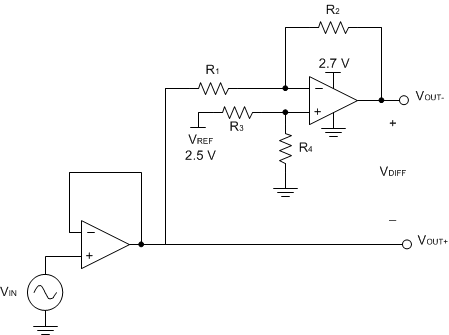SLOS263Y august 1999 – august 2023 LMV321 , LMV324 , LMV358
PRODUCTION DATA
- 1
- 1 Features
- 2 Applications
- 3 Description
- 4 Revision History
- 5 Pin Configuration and Functions
- 6 Specifications
- 7 Detailed Description
- 8 Application and Implementation
- 9 Device and Documentation Support
- 10Mechanical, Packaging, and Orderable Information
Package Options
Refer to the PDF data sheet for device specific package drawings
Mechanical Data (Package|Pins)
- D|8
- DGK|8
- PW|8
Thermal pad, mechanical data (Package|Pins)
Orderable Information
8.1 Typical Application
Some applications require differential signals. Figure 8-1 shows a simple circuit to convert a single-ended input of 0.5 to 2 V into differential output of ±1.5 V on a single 2.7-V supply. The output range is intentionally limited to maximize linearity. The circuit is composed of two amplifiers. One amplifier acts as a buffer and creates a voltage, VOUT+. The second amplifier inverts the input and adds a reference voltage to generate VOUT–. Both VOUT+ and VOUT– range from 0.5 to 2 V. The difference, VDIFF, is the difference between VOUT+ and VOUT–. The LMV358 was used to build this circuit.
 Figure 8-1 Schematic for Single-Ended Input to Differential Output Conversion
Figure 8-1 Schematic for Single-Ended Input to Differential Output Conversion